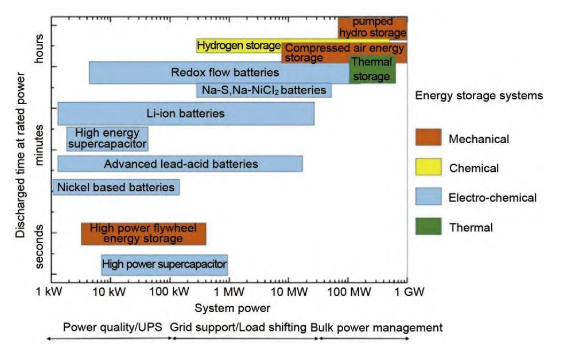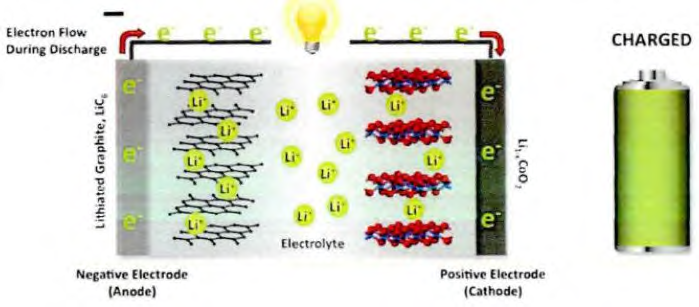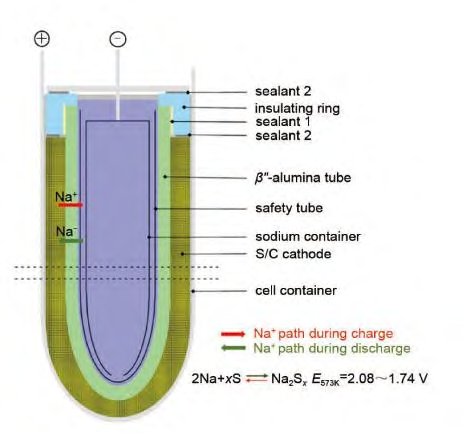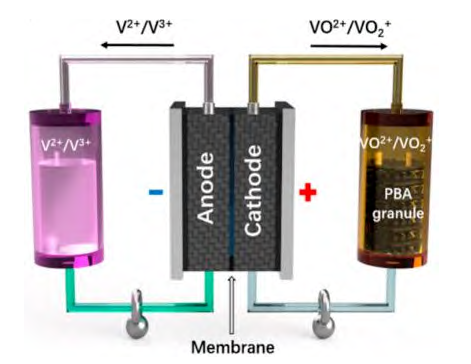| Advantages and disadvantages of energy storage battery technology: lithium ion, |
| Release time:2023-01-04 14:53:53| Viewed: |
Advantages and disadvantages of energy storage battery technology: lithium ion, sodium ion, high-temperature sodium sulfur, all vanadium flow
According to the way of energy storage, energy storage technology is generally divided into mechanical energy storage, electromagnetic energy storage and electrochemical energy storage.
Fig. 1 Comparison of power characteristics and energy characteristics of different energy storage technologies
In recent years, electrochemical energy storage has become the fastest growing energy storage technology due to the rapid development of electrochemical energy storage technology, continuous low cost per kilowatt hour, and multiple application scenarios. According to the statistics of Zhongguancun Energy Storage Industry Technology Alliance, by the end of 2020, the installed scale of global electrochemical energy storage has reached 14.2GW.
The core of electrochemical energy storage technology is battery technology. The in-depth research on battery technology can improve the battery performance, develop low-cost, long-life and efficient batteries, and reasonably customize different energy storage battery systems according to specific scenarios, which can effectively promote the development of electrochemical energy storage technology and expand its market penetration.
At present, the commonly used battery technologies include lithium/sodium ion battery, high-temperature sodium sulfur battery and liquid flow battery. They all have MW level installed capacity worldwide. This paper analyzes in detail the more popular battery technologies in recent years, describes the technical characteristics of different batteries, and analyzes the future development direction of energy storage battery technology in the segmented market.
Type of battery technology
1. Lithium ion battery
Lithium ion battery is an important technical means to realize wireless use of electronic equipment and get rid of traditional fossil energy. Among the current electrochemical energy storage technologies, lithium ion batteries occupy a leading position, accounting for 92% of the installed capacity of global electrochemical energy storage, and are the most important electrochemical energy storage technology at this stage.
Lithium ion battery is a kind of concentration difference battery which forms current in the external circuit by repeatedly disengaging lithium ions between positive and negative electrodes, and is often referred to as "rocking chair battery", as shown in Figure 2.
Common cathode materials include: lithium iron phosphate, lithium cobalate and ternary cathode materials; The cathode materials include graphite, lithium titanate and silicon carbon materials.
The advantages of lithium battery are:
① It has high energy density. The maximum single energy density of lithium iron phosphate battery can reach 210Wh/kg, while the single energy density of ternary battery exceeds 300Wh/kg;
② Fast charging and discharging, suitable for peak regulation and frequency modulation of energy storage power station;
③ High energy conversion efficiency, 80~90%;
④ Fast response time;
⑤ The cycle life has achieved ten thousand breakthroughs (predicted decay slope). Fujian Jinjiang Energy Storage Power Station designed by Ningde Times is expected to achieve 12000 long life cycles of single battery.
Lithium ion batteries also face many outstanding problems in the process of commercial use:
① There are potential safety hazards in the use process. Whether as a power battery or energy storage battery, lithium ion batteries explode or catch fire frequently;
② The reserves of lithium resources are limited. Lithium resources only account for 0.0065% of the earth's crust, and the current lithium resources cannot support the vigorous development of the future automobile electrification and electrochemical energy storage industry.
2. Sodium ion battery
As a secondary battery, the sodium ion battery works in a similar way to the lithium ion battery, relying on sodium ions to shuttle back and forth between the positive and negative poles. Therefore, the sodium ion battery, like the lithium ion battery, is called a "rocking chair battery". Since the radius of sodium ion (0.102nm) is larger than that of lithium ion (0.076nm), it will have a great impact on the coordination number, lattice constant, crystal structure, etc. of positive and negative electrode materials, so attention should be paid to the selection of electrode materials.
Common cathode materials for sodium ion batteries include layered oxides, tunnel oxides, Prussian blue compounds and polyanionic compounds. Negative electrode materials include carbon based materials such as hard carbon, titanium based embedded materials, organic negative electrode materials, alloys and conversion negative electrode materials.
Compared with lithium ion batteries, sodium ion batteries are characterized by:
① Rich in sodium resources, the global sodium content is 2.75%, much higher than lithium (0.0065%);
② Low cost. The low cost of electrode raw materials and collector fluid (aluminum can be used for both positive and negative electrodes) of sodium ion battery makes the theoretical manufacturing cost of sodium ion battery 0.55 yuan/Wh. With the expansion of production capacity and the improvement of process, the cost of its cell is expected to drop to 0.2~0.3 yuan/Wh, which is far lower than the manufacturing cost of lithium ion battery, high-temperature sodium sulfur battery and all vanadium flow battery;
The technology and manufacturing route of sodium ion battery and lithium ion battery are similar, which can well learn from the current production and manufacturing process of lithium ion battery. With high capacity (slightly lower than lithium iron phosphate battery) and rich reserves of sodium resources, sodium ion battery is a battery technology with great development potential and market value in the future.
At present, battery companies represented by Ningde Times and Zhongke Haina focus on the research and development of sodium ion battery technology. In the future, sodium ion batteries are expected to partially replace lithium ion batteries and be used in low-speed transportation and energy storage power plants.
3. High temperature sodium sulfur battery
As an important energy storage technology, high-temperature sodium sulfur battery is suitable for large-scale fixed energy storage. At present, its installed capacity accounts for 3.6% of the global electrochemical energy storage market. The main technology is controlled by Japan NGK, and Shanghai Electric Sodium Sulfur Energy Storage Technology Co., Ltd. and Dongfang Electric Group Co., Ltd. also have some technical reserves. However, its safety problem has been paid much attention and has become a key factor restricting its large-scale industrial development.
The high-temperature sodium sulfur battery is composed of molten electrode and solid electrolyte. The negative active material is molten metal sodium, and the positive active material is liquid sulfur and molten sodium polysulfide, β Type Al2O3 is also used as a solid electrolyte, and its biggest feature is that the positive and negative electrodes conduct electrochemical reaction in the form of liquid.
Fig. 3 Structure and working principle of sodium sulfur battery
The working principle of the high temperature sodium sulfur battery is shown in Figure 3. The working temperature of the solid electrolyte of the high temperature sodium sulfur battery is 300~350 ℃. The sodium and sulfur electrodes are both liquid. During the discharge process, electrons pass through the external circuit from the negative pole to the positive pole, and Na+passes through the β Type Al2O3 solid electrolyte migrates from the positive electrode to the negative electrode and combines with S2 - to form sodium polysulfide product. During charging, the electrode reaction is opposite to the discharge.
The advantages of high-temperature sodium sulfur battery are:
① Rich resources (rich reserves of sodium and sulfur);
② Long charging and discharging life;
③ With high energy density, it has potential for commercialization and sustainable development in the field of large-scale power generation side energy storage.
However, the working temperature of high-temperature sodium sulfur battery is too high (300~350 ℃), which has serious potential safety problems and limits its large-scale industrial development. At present, the production and manufacturing of high-temperature sodium sulfur batteries are mainly concentrated in Japan. Because its safety problem has not been effectively solved, it has not yet produced large-scale effect in the world.
4. Vanadium flow battery
All vanadium flow battery (VRB) realizes the storage and release of electric energy through the mutual conversion of vanadium ions with different valence states. The electrolyte is an aqueous system, which is the only aqueous battery system composed of the same element. Different from the traditional secondary battery, the reaction process of all vanadium flow battery does not involve phase change. Its working principle is shown in Figure 4. The positive electrode stores V5+/V4+sulfuric acid aqueous solution, and the negative electrode stores V3+/V2+sulfuric acid aqueous solution.
Fig. 4 Structure and working principle of all vanadium flow battery
The electrolyte is transported from the storage tank to the stack by the magnetic pump. The vanadium ion components with different valence will undergo redox reaction on the electrode surface, and then be transported back to the storage tank by the magnetic pump after completing the electrochemical reaction. During the charging process, V4+of the positive pole is converted to V5+, and V3+of the negative pole is converted to V2+, and H+is released at the same time. The discharge process is the opposite. The electrode reaction mechanism is as follows (1):
(1) Therefore, its capacity depends on the concentration and volume of electrolyte used, and its power is determined by the electrode area and number of batteries.
All vanadium flow battery has the following advantages:
① Safety and environmental protection. The active material of all vanadium flow battery is a dilute sulfuric acid solution containing vanadium ions, which has no organic matter and is not easy to explode and burn when the battery fails; At the same time, vanadium electrolyte can also be recycled;
② Long cycle life. The number of charging and discharging cycles of the battery is more than 15000, and the service life is 15~20 years, higher than that of lithium ion battery;
③ High energy conversion efficiency and good charge discharge characteristics;
④ Deep discharge (100% charge discharge), able to withstand large current charge discharge, suitable for large current fast charge discharge; The "instant charging" of the battery can be realized by changing the electrolyte, which has the characteristics of rapid response;
⑤ Large energy storage capacity, ranging from hundreds of kilowatts to hundreds of megawatt hours, suitable for large capacity fixed energy storage.
The outstanding problems of vanadium redox flow battery are:
① The manufacturing cost is too high. According to the statistics of Dalian Rongke Company, the manufacturing cost of vanadium flow battery is about 4000 yuan/kWh, which hinders the popularization of vanadium battery;
② It is bulky and difficult to handle. Under the same energy storage capacity, the vanadium flow battery is heavy, bulky and difficult to handle. It is not suitable for convenient transportation equipment such as electric vehicles, but can only be used for large-scale fixed energy storage;
④ The specific energy is low and difficult to further improve. The specific mass energy of vanadium battery is only 1/3~1/2 of that of lithium battery or high-temperature sodium sulfur battery.
Summary of different battery characteristics
The application scenario of electrochemical energy storage highly depends on the technical characteristics of the battery. For the above common battery technologies, their cost, performance and potential application scenarios are analyzed respectively and summarized in Table 1 below.
As an emerging industry, energy storage is in the stage of active policy guidance, continuous technology iteration, and gradually mature market, facing multiple opportunities and challenges. On the one hand, energy storage is the key to building a flexible power supply, which will usher in significant development under the new power system and the "dual carbon" goal; On the other hand, the current energy storage battery technology needs to be further improved in terms of cost, safety, performance, standard system construction, etc.
In the next few years, the electrochemical energy storage technology will still be dominated by lithium ion batteries. With the gradual consumption of lithium resources, the low cost, safety and rich stock of sodium ion batteries are increasingly prominent, and the performance is constantly optimized. In the future, sodium ion batteries will usher in greater development in the field of energy storage.
In addition, with the gradual emergence of the demand for long-term energy storage in the large power grid, new long-term energy storage technologies such as liquid flow battery with super long life will also play an important role in specific fields. With the continuous progress of battery technology and the enrichment of application scenarios, the energy storage battery technology will enter the era of diversified development in the future. It is necessary to give full play to the role of the energy storage market in the allocation of resources, so that various battery technologies can be developed in a coordinated manner according to their characteristics. |









